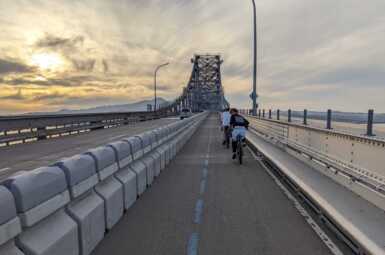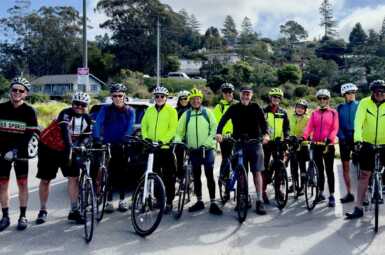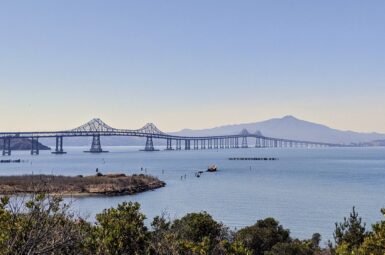November 2022 Election 2022 Corte Madera Town Council Candidate Questionnaire
As a 501(c)3 nonprofit organization, Marin County Bicycle Coalition cannot endorse candidates for public office, but we are able to share information so that you can arrive at your own conclusion. Below are the 2022 Town of Corte Madera candidates’ responses to our questionnaire on bicycling in Marin. We have made no content changes. Thanks to the candidates for their time and thoughtful answers.
Candidates’ campaign websites may be accessed by clicking on those with a highlighted name. Those who did not provide a campaign website are not highlighted.
Here are the candidates on the November ballot for the Town of Corte Madera:
Personal Travel
1. Do you ride a bicycle? If so, for what purposes and how often? (transportation/road/mtb)
James Andrews: No response
Eli Beckman:
-
a. Commuting: 1 day/week
-
b. Errands: 1 day/week
-
c. Road recreational: Never
-
d. Mountain biking or trails: Never
Robert Lucarini:
-
a. Commuting: Never
-
b. Errands: 1 day/week
-
c. Road recreational: 1 day/week
-
d. Mountain biking or trails: 1 day/week
Pat Ravasio:
-
a. Commuting: Almost never (occasionally I ride my bike to our real estate open houses)
-
b. Errands: Occasionally for shopping
-
c. Road recreational: About one day per week
-
d. Mountain biking or trails: Never
Rosa Thomas: No
2. If you own a bike, what type of bike(s) do you have and ride? If not, when was the last time you rode a bike, and where (on vacation, for example)?
James Andrews: No response
Eli Beckman:
I use my family’s Marin mountain bike, but I just use it for errands and to get to and from meetings around town.
Robert Lucarini:
I primarily use a mountain bike with low gears so I can tow my children up hills.
Pat Ravasio:
I have a Cannondale, which was a gift, after my favorite bike ever, a high-end Specialized, was stolen.
Rosa Thomas:
I do not own a bike. I last rode a bike 53 years ago, as an 8-year-old. I was unaware that there were no brakes and I slammed into the side of my house. It would have been best to try a different bike. However, no other bike was available, so I never rode again, unfortunately.
Vision
3. In your own words, describe your vision for the future of transportation in Corte Madera.
James Andrews: No response
Eli Beckman:
I want to see an emphasis on non-motorized transportation (plus e-bikes) and less emphasis on motor vehicles—I think walking and biking have myriad important public benefits (health, safety, pollution, etc). Where we do have motor vehicles, I want to see everything electrified (potentially hydrogen too, but zero emissions is key) and more emphasis on public transit over personal vehicles.
Robert Lucarini:
Any journey within the town limits should be equally pleasant no matter what form of transportation is used.
Pat Ravasio:
I’ve been involved, alongside my husband, for at least a decade, working to improve bicycle and pedestrian infrastructure in Corte Madera. It’s one thing we always agree on — that our roads must be safer if we ever hope to get more people out of cars and onto bicycles. After traveling to Amsterdam and meeting with engineers from Delph (from the Netherlands) on-site in Corte Madera, I can envision a much larger bicycle ridership in our town, for commuting, errands, and recreation. We have a relatively level terrain, great weather, and ample abandoned railroad right of ways — all things that should make a true bicycle friendly community possible. One project I am particularly proud of working on is the new Cal Trans Overcrossing at US 101 and Tamalpais. I personally recruited the architectural firm of Skidmore, Ownings and Merrill to design a NYC Highline inspired multi use bridge over US 101, which Cal Trans recently presented back to Corte Madera as an option for the rebuilding of this overcrossing. A huge win for Corte Maderans.
Rosa Thomas:
I envision a Corte Madera with greatly reduced vehicle traffic and greatly increased bike pedestrian traffic. Improving the overcrossing between the east and west sides of town is key in this endeavor. I support CalTrans Alternative 4B for reconfiguring the US 101 Tamalpais Drive overcrossing/on-off ramps. The project would meet Corte Madera’s Complete Streets specifications which call for a separated multi-use path that is appropriate for bicyclists and pedestrians of a wide range of ages, abilities, and experience levels.
Traffic
A large proportion of peak hour traffic is made of people driving their children to school. While some people live too far to easily walk or bike to school, many parents are simply afraid to let their children travel by foot or by bicycle because of the high volume and speeds of car traffic.
4. What strategies would make more parents feel safe with their children walking or biking to school, thereby reducing traffic and making everyone else’s trip to school a little safer?
James Andrews: No response
Eli Beckman:
I think continuing to embrace the Safe Routes to School philosophy is key—we need to continue improving our bike/ped infrastructure so that parents can feel confident knowing their kids have a healthy, safe, and fun way to get to school that doesn’t involve driving! I think a top priority on this must be making sure we have hardened barriers between multiuse paths and busy roadways, not just curbs or striping.
Robert Lucarini:
Start with large increase in the number of bike and pedestrian signage on roads and posted. The residents and guests to Corte Madera should not wait for repaving or other road work to occur before any improvement with safety can be achieved.
Pat Ravasio:
We need safe and separate class one bike lanes connecting all neighborhoods with our elementary, middle, and high schools. I also think there should be incentives for children to ride their bikes to school, such as occasional surprise early dismissals for all those who rode a bike that day. Other creative policies could quickly help change our car-centric culture.
Rosa Thomas:
Walking and biking on paths that are safely separated from vehicle traffic is key. There is also safety in numbers and I think that advocating for school walking and riding “buddies” could be key for parents who are not only concerned about safety from vehicles, but about kids being safe from other threats, if their kids walked or biked alone.
A survey from the Transportation Authority of Marin (Figure 18, p. 51) found that over half of Marinites would like to bike more than they currently do. This backs up research that shows that over 50% of adults are interested in biking, but concerned about the threat of fast-moving cars.
5. What concrete steps can be taken to allay these concerns and make people feel safe on bicycles?
James Andrews: No response
Eli Beckman:
Again, I think hardened barriers between roadways and multi-use paths is key. I know that when I bike around town I always have a slight worry of a car jumping the curb in the back of my mind. Even though that’s extremely rare, people on bikes often feel vulnerable when riding near roadways, and don’t want to take that risk with their safety.
Robert Lucarini:
Same as 4. More signage will help keep drivers of aware of foot and bike traffic especially on the hillsides of Corte Madera.
Pat Ravasio:
Again, safe and separate bike paths throughout our community are necessary to make riders feel safe.
Lowering speed limits where possible might also help.
Rosa Thomas:
Class I paths that allow pedestrians and bicyclists travel with a physical barrier between them and vehicle traffic are the best solution. These should be the first choice whenever possible.
Safety
Traffic deaths and injuries are on the rise, both nationally and in Marin (this includes all road users, not just bicyclists). Many cities in California have enacted so-called Vision Zero
resolutions, setting an explicit goal to eliminate traffic deaths.
6. If elected to town Council, will you support such a resolution? If so, what actions do you see as being needed to improve safety? What are the relative roles of infrastructure, enforcement, and education?
James Andrews: No response
Eli Beckman:
I absolutely support Vision Zero, and I think it’s critical that our leaders come at this issue from both sides: making biking/walking safer, but also making driving less dangerous. That means
enhanced protection for multiuse paths (hardened barriers and physical separation), as well as strategies like calming car traffic and re-engineering intersections between paths and roads.
I think infrastructure, enforcement, and education are all key, although I see infrastructure and education as the foundations, and enforcement as a more severe tool to be used when
providing adequate, safe infrastructure and robust public education are not sufficient. Most people will choose to do the right thing when given the tools, but it’s important to have
enforcement as an option when it’s needed to protect public safety.
Robert Lucarini:
I would support a county wide approach to the Vision with commitment to flushing out the collision profiles most relevant to the TOC.
Pat Ravasio:
This sounds interesting. I would like to know more about Vision Zero. I certainly agree with its objectives.
Rosa Thomas:
As Corte Madera looks at new housing development and addressing connection between the two sides of town, there is an opportunity to incorporate design principles to make cyclists and pedestrians safer. This will also be a great time to analyze the speed limits and how to enforce individual road users’ compliance with safety policies. I would certainly support the efforts to eliminate traffic deaths in Corte Madera.
Climate Change
The latest IPCC report states clearly that greenhouse gas emissions need to be reduced quickly in order to stave off the worst effects of climate change. According to Corte Madera’s most recent Greenhouse Gas Inventory, transportation accounts for a majority (53%) of local greenhouse gas emissions. Given that battery electric cars make up 3% of California’s vehicle
fleet, and only 12% of new cars sold.
7. does reducing overall driving have a role in meeting our climate targets? If so, what policies can support transit, walking, and bicycling in place of driving for short trips?
James Andrews: No response
Eli Beckman:
Absolutely! I believe the most effective ways to encourage biking and walking for short trips (as opposed to driving) is to make it safe and convenient. Critical safety features include hardened barriers to protect users of bike/ped paths from cars when those paths are along roadways. Convenience is also key, and we can make biking/walking more appealing by providing adequate public bike storage (racks and lockers), and making sure multiuse paths are planted with trees for shade and have water fountains and benches for bikers and pedestrians to rest.
Robert Lucarini:
Leverage grant opportunities such as https://visionzeronetwork.org/resources/safe-streets-for-all-grants/
Pat Ravasio:
In Corte Madera, fixing the Tamalpais overcrossing of US 101 could play a major role in getting more people on bicycles. It is a very dangerous crossing now, with few casual riders even attempting it. Because this is a key connector point for our two sides of town, and between our two major shopping centers, a safe and separate multi use path could make a big difference. Caltrans is also looking into making the bus stops safer and more accessible too, which should also help.
Rosa Thomas:
As we have seen during the pandemic, many countries have measured improvements in air quality, once the population drastically reduced their driving. First of all, I am a big proponent of public transit and many public buses and trains are now electric. Although it is not in the purview of the Town Council, I would support increasing electric bus routes and regularity so that this mode of transportation is always an easy option when one is going far or needs to get somewhere fast or those who unable to walk or cycle. If the transit agency wished to increase service in Corte Madera, I would enthusiastically support this.
I would support policies such as creating, widening or improving existing bike and pedestrian paths. Barriers between the rider/walker and vehicles is key to people feeling comfortable enough to give up driving for short trips.
Additionally, deciding where to locate everyday conveniences, like grocery stores, services and restaurants could be key to making sure that such places are close enough to where people live, that they would be more likely to walk or bike there. Mixed-use development should surely be considered in Corte Madera’s future.
Project Delivery
Bicycle/pedestrian plan implementation is notoriously slow with typically fewer than one new bike lane project opening every year.
8. What steps would you take to hasten the project delivery process from inception to ribbon-cutting?
James Andrews: No response
Eli Beckman:
While most construction-related delays are out of the Council’s hands, I am keenly interested in speeding up project design and permitting however we can, without compromising the quality of the finished design. I think we should continue the one-meeting process we’ve been using to approve designs, authorize the Town to advertise for bids, and awarding the contract—in the past, this sometimes took 2-3 meetings, which can delay a project by months. I do, however, think it’s critical that we do not skimp on community engagement—when done right, community engagement can actually create the public excitement that incentivizes even faster project delivery!
Robert Lucarini:
I would work with the department of public works to help prioritize these projects.
Pat Ravasio:
Ahh, that’s a difficult one. Definitely by not delaying votes unnecessarily, and by creating a sense of urgency. And not letting “perfect” get in the way of “good.” Afterall, as Bill McKibben says about climate change, “Winning slowly is the same as losing.”
Rosa Thomas: No response
In all things, there is a tension between “perfect but slow” and “quick and good enough.” Recent years have seen a move toward so-called “quick-build” infrastructure, allowing reconfiguration of streets to facilitate safer walking/biking without a years-long engineering process. While quick-build projects may be less aesthetically pleasing than the standard process, they are cheaper and happen much faster.
9. How do you rank aesthetic concerns of biking/waking infrastructure in comparison to those of cost and project speed?
James Andrews: No response
Eli Beckman:
This question gets at the heart of why it’s so critical to develop a quality project design/delivery process. While we all like to strive for perfection, it’s also critical to be practical in delivering public services and projects, recognizing what’s possible, and performing the necessary cost-benefit analysis. Having bike/ped infrastructure that works but isn’t gorgeous is far preferable to having no infrastructure at all; at the same time, aesthetics are often tied closely to other components of the overall user experience that can often be the deciding factor between
whether a piece of infrastructure is used or neglected by the community.
I believe it’s important to evaluate each project holistically, as many “aesthetic” upgrades actually provide multiple user benefits that work to increase infrastructure use and uptake.
Consider a street running through a hot city, with a class III bikeway: a narrow, unprotected band in a sea of asphalt. Biking here is hot, noisy, and feels unsafe as cars whizz by. Now
consider instead a class I bikeway, with physical separation from the roadway provided by a hardened barrier, planted with trees. It’s beautiful, sure, but much more importantly, there is shade and a strong feeling of safety. It’s easy to imagine this path having significantly higher usage, and likely a more favorable cost-benefit ratio than a cheaper bike lane used by only the most brave souls.
A key tool in satisfying both of these competing needs—speed/budget, and user experience—is developing a set of standards that can be easily applied across multiple projects, as well as a streamlined permitting process. I also think we need to be more strategic in how we construct infrastructure, increasing modularity and designing with an eye to making future modifications easier, quicker, and less expensive.
Robert Lucarini:
Same answer as 4). Which is in support of such quick-build projects
Pat Ravasio:
Corte Madera’s efforts at “complete streets” projects have been a success. Along Tamal Vista, some new paint and key work on cross walks and intersections has made a significant difference in how safe that road feels on a bike or on foot. This was fairly quick work that was effective. I would definitely support more projects like this one.
Rosa Thomas:
The goal of expanding cycling and walking infrastructure is to make sure it is inviting to those who are less likely to travel this way. Dedicated cyclist will cycle no matter what the path looks like. But to get the participation of a greater, more impactful number, people may have to be enticed. And that’s where the aesthetics come in. Therefore, I think there has to be a balance between aesthetic concerns and concerns of cost and project speed. In the end, a majority of Corte Maderans will need to change their traveling modes in order to reduce traffic and emissions. A project that is only utilized by those who already walk and bike won’t be enough.
Car Parking
Much of Marin has narrow streets, but on-street parking typically takes up between 30-40% of the street space between the curbs, and is often in tension with the need for dedicated bike lanes.
10. In your mind, are bike lanes ever sufficiently important to justify removing on-street parking, and in what circumstances would you consider that to be the case?
James Andrews: No response
Eli Beckman:
Definitely. At the most fundamental level, sustainable building means providing for a building’s needs on-site. That doesn’t just mean rooftop solar; it also means parking! The public right of
way is just that, and shouldn’t be monopolized by private cars sitting for hours on end. I believe there are many cases where a safe bike lane provides more public benefit than on-street
parking in the same location, especially in areas that already have poor bike infrastructure.
Robert Lucarini:
This will depend on whether the impact is on residential street parking vs town shop parking.
Pat Ravasio:
Yes, if there is no other way to achieve safety for bicyclists than to remove on-street parking, then the parking should go. It’s that simple. If we want to shift our transportation culture to non-fossil fuel burning alternatives, we have to shift our priorities too. We can’t have everything.
Rosa Thomas:
Determining usage of parking for a particular business or home will need to be weighed. Also, existing alternatives to on-street parking will need to be examined. Unfortunately, there is not a “one size fits all” solution to this problem.
11. Would you say that Corte Madera has (A) not enough, (B) too much, or (C) just enough space dedicated to parking cars? If (A), what areas of town would you consider to convert to parking, and if (B) what would you do with the space that was previously parking?
James Andrews: No response
Eli Beckman:
(B) too much. Public parking is important for businesses, but sprawling parking lots are often a waste of land. Parking would be much better provided in multi-level garages, allowing our
precious land to be used for the things our community actually enjoys and benefits from, most importantly parks and outdoor gathering spaces.
Robert Lucarini:
– C
Pat Ravasio:
I would like to see more carpool and park-and-ride parking close to US 101. An easy pull on and off meet-up lot for carpools and taxis could be added to the Caltrans designs for the Tamalpais overcrossing. There’s already a great deal of open space there and there will be even more once the huge cloverleaf entrance ramps are removed. For these, I would be looking for some kind of permeable (but still ADA) surface.
Rosa Thomas:
Again, there is no single answer to this question. In the flatter neighborhoods, there is about the right amount of parking. In the hillier areas, there is way too little. And at the shopping centers, it’s about right.
Bike Parking
Many MCBC members report challenges with bicycle parking in the downtown area. Racks are few and far between, or not easily visible from shops and areas with high levels of foot
traffic.
12. What steps or policies would you advance on the council agenda to bring about better bicycle parking and reduce the chance of bicycle theft?
James Andrews: No response
Eli Beckman:
I would advocate for a streamlined permitting process where businesses can place bike storage infrastructure in public places by-right, so they don’t need to get tied up in planning fees and design review. I would also support reducing or possibly eliminating fees for such projects.
Robert Lucarini:
Put additional bicycle parking near the bus stop and in select areas on certain streets with store fronts
Pat Ravasio:
I would very much like too see more and better bike racks at our shopping malls. A manager at REI told me that an entire bike rack, filled with bikes, was stolen from Town Center a couple of years back. With thefts on the rise, and thieves getting more sophisticated, we need to keep up.
Rosa Thomas:
Where safe to do so, bike racks should be made available within observable sight lines. Walkway widths that allow use for those with disabilities and mobility issues must be preserved, however.
Due to recent changes in state law, the cities and towns of Marin are being compelled to zone for more multi-family housing. However, traffic is already unsustainable. To address this,
many cities have implemented what is known as Transportation Demand Management (TDM) in new developments, including replacing some car parking with bicycle parking, giving residents transit passes, or providing shared cars.
13. Do you support steps to require secure bike parking in new housing (and other policies to reduce driving), and, if so, how would you seek to implement them?
James Andrews: No response
Eli Beckman:
Absolutely. Providing secure bike parking should be a given in new residential development, and I would support requiring developers to include bike racks and lockers in projects, perhaps along the lines outlined in various LEED programs. Such a requirement can and should be incorporated into the Town’s multifamily development design standards.
Robert Lucarini:
Yes, I would support a TDP program for new developments.
Pat Ravasio:
Yes, I would support this, and I think bike parking infrastructure can and will be handled as part of the regular planning, design, and community input stages of a housing project.
Rosa Thomas:
I would support requiring developers to include plans that include either community or individual secure bike storage in their proposals.
Corte Madera-Specific Question
Re-opening the Alto Tunnel is a goal long-sought by pedestrian and bicycle advocates in Marin, as it would obviate the need for a long, out-of-direction route between Mill Valley and Corte Madera, one that involves significant climbing. Thanks to the passage of the federal infrastructure bill, there are now large amounts of federal funding for GHG-reducing projects like this.
14. Do you support the reopening of the Alto Tunnel to bicycle and pedestrian travel? If so, what steps would you take to push along the project? If not, what barriers do you see as being insurmountable?
James Andrews: No response
Eli Beckman:
I think reopening the Alto Tunnel to bike and pedestrian traffic would be a nice amenity for the community, and would certainly make commuting to the city by bike easier. However, I believe cost is the most challenging barrier on that project; while I certainly see the project’s benefits, I am also keenly aware that those dollars would come at the expense of other bike/ped improvements that, while smaller, will have to be evaluated in aggregate in order to determine where the optimum community benefit lies. I think getting updated studies on potential user numbers and project cost would be key to this evaluation.
Robert Lucarini:
I’ve have been fascinated with the idea of reopening the Alto Tunnel for bicycle and pedestrian use. The major obstacles would be the implementation of safety infrastructure such as widening the tunnel, proper ventilation, creating escape routes every “x” yards, proper lighting and fire extinguishers.
Pat Ravasio:
Yes, I support the reopening of the Alto Tunnel. While it’s an expensive project, it would be a complete game changer for connecting Mill Valley with the rest of Marin. If it doesn’t happen, the Camino Alto hill could end up being the only section of the entire north-south greenway which can only be traversed by expert riders. I would work actively with our BPAC and MCBC to try and accelerate this project, especially if it appears that funds may be available.
Rosa Thomas:
The job of a town council member is to be a good steward of the town’s finances. They must strive do what’s best to benefit the most people, at a cost that makes sense. Corte Madera is town of just over 10,000 people. The low estimate of reopening the Alto Tunnel is close to $50 million. When weighing the number of people who would use it on a daily basis against other needs of the community, I would have to say I do not support the Town taking on this endeavor.
Wrap Up
15. Why should people who ride bikes (or those who want to ride bikes but don’t yet) vote for you?
James Andrews: No response
Eli Beckman:
Addressing climate change is my top priority as a Councilmember, as it’s the most serious threat Corte Madera faces. The goal of fighting climate change is intimately entwined with the goals of the biking community, as strategies that make it safer and more pleasant to bike will necessarily have the effect of taking cars off the road. I stand 100% behind the need to build on our progress in creating an extensive and interconnected network of safe and convenient bike infrastructure, not only so that bikers can bike with confidence, but so that today’s drivers will make the healthy lifestyle decision to become tomorrow’s bikers!
Robert Lucarini:
If elected, I will diligently pursue initiatives to make Corte Madera safer for pedestrian and bicycle travel.
Pat Ravasio:
Firstly, they should vote for me because of all of my answers to your previous 15 questions. Secondly, because I have proven to be effective in getting things done for Corte Madera. And lastly, because this is a personal issue for me, after my husband was seriously injured on his bicycle by a distracted motorist in 2018. I really don’t think you could find a more devoted bicycle infrastructure advocate running for any council in Marin, and certainly not in Corte Madera. Thank you for your consideration.
Rosa Thomas:
I believe that we must reduce emissions, become more physically active and enjoy the great outdoors that Corte Madera provides. Bicycles help folks do all of that. I will always listen to the needs of cyclist and support steps to make Corte Madera a more biking- and walking-friendly town.
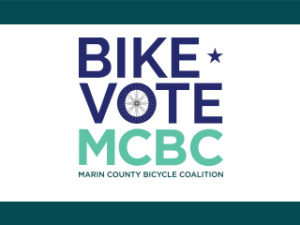
members make it happen!
We’re fighting for a more bike-friendly future in Marin. Are you with us? Join Marin County Bicycle Coalition today.
